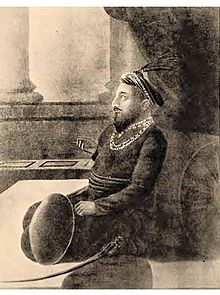
Back مرشد قلي خان Arabic Mürşüdqulu xan Azerbaijani মুর্শিদকুলি খাঁ Bengali/Bangla Murshid Quli Jafar Khan Catalan Murshid Quli Khan German Murshid Quli Jafar Khan Spanish Murshid Quli Khan French मुर्शिद कुली खां Hindi ムルシド・クリー・ハーン Japanese Murshid Quli Khan (Bengalen) Dutch
| Murshid Quli Khan | |||||
|---|---|---|---|---|---|
| Nasir Jung Ala ud-Daulah Mutam ul-Mulk Nawab Nazim Ja'far Khan Bahadur Nasiri | |||||
 | |||||
| 1st Nawab of Bengal, Bihar and Orissa | |||||
| Reign | 1717 – 30 June 1727 | ||||
| Coronation | 1717 | ||||
| Predecessor | Position established | ||||
| Successor | Shuja-ud-Din Muhammad Khan | ||||
| 30th Subahdar of Bengal | |||||
| Reign | 30 March 1712 - 1717 | ||||
| Predecessor | Azim-ush-Shan | ||||
| Successor | Position abolished | ||||
| Badshah | Bahadur Shah I Jahandar Shah Farrukhsiyar | ||||
| Born | Surya Narayan Mishra c. 1660 Deccan Plateau, Mughal Empire | ||||
| Died | 30 June 1727 (aged 66–67) Murshidabad, Bengal | ||||
| Burial | Katra Masjid, West Bengal, India | ||||
| Spouse | Nasiri Banu Begum | ||||
| Issue |
| ||||
| |||||
| House | Nawabs of Bengal | ||||
| Dynasty | Nāṣirī | ||||
| Father | Haji Shafi Isfahani (foster father) | ||||
| Religion | Shia Islam[1][2][3] | ||||
| Other names | Mohammad Hadi Mirza Hadi Ja'far Khan | ||||
| Military career | |||||
| Allegiance | |||||
| Service/ | Nawab of Bengal | ||||
| Rank | Nawab | ||||
| History of Bangladesh |
|---|
 |
|
|
Murshid Quli Khan (c. 1660 – 30 June 1727), also known as Mohammad Hadi and born as Surya Narayan Mishra, was the first Nawab of Bengal, serving from 1717 to 1727.
Born a Hindu in the Deccan Plateau c. 1670, Murshid Quli Khan was bought by Mughal noble Haji Shafi. After Shafi's death, he worked under the Divan of Vidarbha, during which time he piqued the attention of the then-emperor Aurangzeb, who sent him to Bengal as the divan c. 1700. However, he entered into a bloody conflict with the province's subahdar, Azim-us-Shan. After Aurangzeb's death in 1707, he was transferred to the Deccan Plateau by Azim-us-Shan's father the Mughal Emperor Bahadur Shah I. However, he was brought back as deputy subahdar in 1710. In 1717, he was appointed as the Nawab Nazim of Murshidabad by Farrukhsiyar. During his reign, he changed the jagirdari system (land management) to the mal jasmani, which would later transform into the zamindari system. He also continued sending revenues from the state to the Mughal Empire. He received various titles from the Mughal emperors such as Kārtalab Khān, Murshid Quli Khān, Jafar Khān and Mutamin al-Mulk Ála' al-Dauläh Jafar Khān Nasiri Nasir Jang Bahadur successively. He built the Katra Masjid mosque at Murshidabad where he was buried under the staircase after his death on 30 June 1727. He was succeeded by his son-in-law Shuja ud Din Muhammad Khan.
- ^ Rizvi, Saiyid Athar Abbas (1986). A Socio-intellectual History of the Isnā ʼAsharī Shīʼīs in India: 16th to 19th century A.D. Vol. 2. Munshiram Manoharlal Publishers. pp. 45–47.
- ^ Rieck, Andreas (15 January 2016). The Shias of Pakistan: An Assertive and Beleaguered Minority. Oxford University Press. p. 3. ISBN 978-0-19-061320-4.
- ^ K. K. Datta, Ali Vardi and His Times, ch. 4, University of Calcutta Press, (1939)
- ^ Rai, R. History. FK Publications. p. 44. ISBN 9788187139690.
© MMXXIII Rich X Search. We shall prevail. All rights reserved. Rich X Search